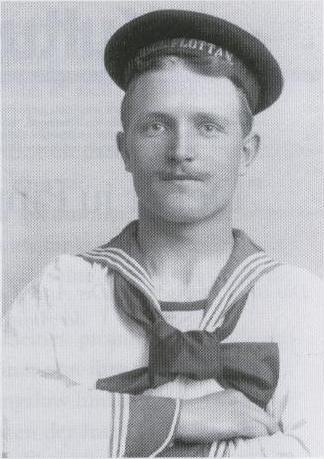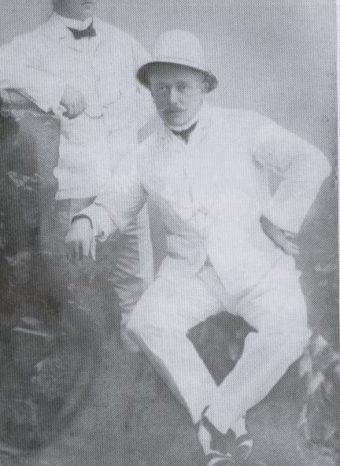Carl Emil Pettersson: The Unlikely King
 On Christmas Day 1904, Carl Emil Pettersson stood at a crossroads – either he was going to be eaten by hungry cannibals or become a member of the Tabar people. Happily, the latter occurred, after which he led a rather remarkable life.
On Christmas Day 1904, Carl Emil Pettersson stood at a crossroads – either he was going to be eaten by hungry cannibals or become a member of the Tabar people. Happily, the latter occurred, after which he led a rather remarkable life.
Born in October 1875 in Sweden, at around the age of 17 Pettersson went to sea. Working his way across the Pacific, by 1898 he was employed by the Neuguinea-Compagnie, a German trading company.
While recruiting among the islands of Papua New Guinea aboard the Herzog Johan Albrecht in December 1904, the ship sank. Pettersson survived and made it to shore on the island of Tabar, one of the hundreds of islands that today make up the island nation.
Finding himself under a hibiscus bush and surrounded by a fair number of the local people, Pettersson knew he was in trouble as the Tabar were known to engage in cannibalism. However, instead of eating him, the natives decided to take him to their king, Lamy, with contemporary reports claiming it was because the natives had never seen someone with blue eyes- Pettersson had bright blue eyes.
Also impressed with the young Swede, Lamy allowed him to live and reside on the island. At some point Pettersson caught the eye of King Lamy’s daughter, Princess Singdo, and the two married in 1907, three years after his arrival on the island.
 Industrious, he took up trading in dried coconuts, called copra, and even built a successful coconut plantation, Teripax. Respectful of his neighbors and a conscientious employer, the man they ultimately called Strong Charley was such a favorite of the people that when old King Lamy died, Pettersson became the Tabar’s new king.
Industrious, he took up trading in dried coconuts, called copra, and even built a successful coconut plantation, Teripax. Respectful of his neighbors and a conscientious employer, the man they ultimately called Strong Charley was such a favorite of the people that when old King Lamy died, Pettersson became the Tabar’s new king.
Together with Singdo, they had nine children, with one dying in infancy; they also acquired two more plantations, Maragon on Simberi Island, and Londolovit on Lihir Group islands.
Unfortunately, Princess Singdo succumbed to puerperal fever, an infection of the reproductive tract related to childbirth and miscarriage, in 1921.
With a pile of kids and no one to care for them, Pettersson returned to Sweden to find a wife and stumbled upon Jessie Louisa Simpson. The two married in 1923 and returned to Tabar Island, but during Pettersson’s sojourn, the plantations had languished.
Near bankruptcy and both suffering from malaria, Pettersson and Jessie tried to revitalize the plantations, but between a failing market and bad investments, they were unable.
Not all was lost, however, because Pettersson discovered a deposit of gold on Simberi Island. Later, Jessie and Pettersson left separately for Australia, and Jessie continued on to Sweden, where she died of malaria and cancer in May 1935.
Pettersson never made it past Australia and died in Sydney of a heart attack on May 12, 1937.
If you liked this article, you might also enjoy our new popular podcast, The BrainFood Show (iTunes, Spotify, Google Play Music, Feed), as well as:
- The Peasant Who Became a Powerful Emperor: Basil I
- The Forgotten Emperor of the United States and Protector of Mexico, Norton I
- The Man on the Raft: The Story of Poon Lim
- The Would Be King
- The Truth About the Legend of Pelorus Jack
Bonus Facts:
- Speaking of cannibalism and shipwrecks, in 1820 a huge sperm whale destroyed the whaling ship Essex about 2,000 miles west of South America, with the 21 man crew taking refuge on three small boats with almost no supplies. Their choice at this point was to head for known habitable islands that they feared were inhabited with cannibals, 1,200 miles away, or head for South America 2,000 miles away, but about 4,000 miles by the quickest sailing route due to the winds that time of year. Despite this distance, they chose South America. During their journey, they did at one point encounter an island that they more or less stripped of its resources to help sustain themselves. They also left three men behind there, at the time thinking likely to their doom, to help conserve supplies and increase the chances the others would make it back. What followed was an incredibly gruesome tail. As they traveled, they steadily lost crew due to lack of nourishment. At a certain point, they were forced to give up burying their men at sea and, instead, began eating them and drinking their blood. They eventually even had to resort to not waiting for someone to die, but, rather, drew lots for who was to die and nourish the others with their body. In the end, 95 days after their ship was destroyed, they were rescued with only five left alive aboard the two remaining small ships (one was lost along the way with the crew never heard from again). Miraculously, the three left on the depleted island, though near death when eventually found, survived the event.
- Pettersson is widely regarded as the inspiration for the father of Pippi Longstocking, an absent buccaneer captain.
- The man most-likely to be the inspiration for Daniel Defoe’s Robinson Crusoe (1719) was Alexander Selkirk, a British privateer who was left behind on an island off the Chilean coast because he didn’t trust the seaworthiness of his captain’s ship. During his time on the island, Selkirk entertained himself with reading the Bible and chasing goats, and at one point, had to actually hide from human contact when a group of enemy mariners (Spanish) came shore. Stuck alone for more than four years, by the time privateer Captain Woodes Rogers found him, Selkirk at first had difficulty speaking as he hadn’t done so in years. However, several of the crew under Rogers’ command were suffering from scurvy and Selkirk set about supplying them with needed food. He got so good in the graces of the captain that he was made first mate before they set off, and was given one of the two ships to captain during the remainder of the voyage. A book was subsequently written by Captain Woodes Rogers’, which included the tale of Selkirk: Rogers’ A Cruising Voyage Round the World: First to the South-Sea, thence to the East-Indies, and Homewards by the Cape of Good Hope. Selkirk himself was also interviewed several times about his adventure and gained a certain amount of notoriety for it throughout England.
- If you’re wondering what happened to the ship Selkirk refused to get back on in the first place because he didn’t believe it was seaworthy anymore, it sunk off the coast of Peru shortly thereafter taking most of the remaining 41 crew members with it. Only eight of the crew survived, including the captain. They managed to swim to a nearby island from where the ship sank, but were subsequently taken captive by Spaniards and were imprisoned where “the Spaniards put them in a close dungeon and used them very barbarously.” Only the captain made it away from there alive, eventually managing to return to Britain.
- Another fascinating castaway was a French noblewoman Marguerite de La Rocque de Roberval. She was accused of having an affair with someone aboard the ship she was on (she was a guest of her relative, the newly made Lieutenant General of New France). The individual she had an affair with was depicted as a low birth individual, but this is thought to have been a lie to protect the man’s aristocratic family from shame. His name was never given. In any event, Marguerite was left on the “Isle of Demons” in the Gulf of St. Lawrence near present day Quebec in 1542. With her was the young man she was supposedly having an affair with and a maid servant (there are conflicting accounts on whether she was left on the island with her servant and her lover jumped off the ship and swam to shore to join her or whether he was left on the island and she voluntarily chose to join him). Whatever the case, both the man and servant died on the island, along with a baby that Marguerite had while their (the baby dying of malnourishment). Marguerite, on the other hand, managed to live through the ordeal, which lasted a few years. She was eventually rescued by a fisherman and managed to return to France where she became a school teacher. Her story became famous throughout France and was included in Queen Marguerite of Navarre’s work: Heptaméron.
- The woman behind the children’s book, Scott O’Dell’s Island of the Blue Dolphins (1960) was Juana Maria. Born and raised on San Nicholas Island off the coast of California, Juana Maria was left behind after missionaries evacuated the island in 1835 (she was searching for her infant child, whom she never found). Left utterly alone for the next 18 years, Juana lived in a cave, fished with seashells, captured seals and birds (and made their feathers and skins into clothes) and weaved bowls and baskets from grass. She was “rescued” in 1853 by Captain George Nidever and taken to Santa Barbara where she used hand gestures to relay her remarkable tale. She died within two months of reaching civilization, however, from dysentery.
| Share the Knowledge! |
|





“Marguerite had while their (the baby dying of malnourishment). ”
I think you mean “while THERE”..
Carl Emil Pettersson is my Dad’s father.. it’s amazing how we have a big family history!
I’m actually named after My Great Grandmother Sindu
I was mean’t to say He is actually my great grandfather, as my dads dad is his dad.